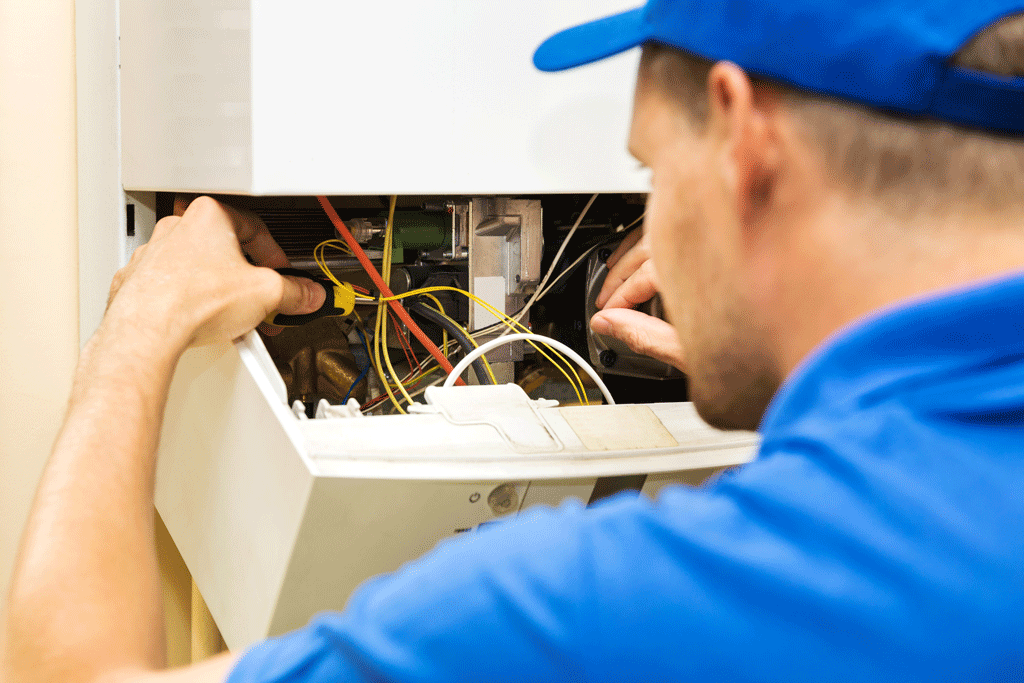
The Ultimate Guide to Emergency Heating and AC Repair Services
Have you ever pondered, “What’s the real deal with emergency heating and AC repair services?”
If so, you’re among countless homeowners who grapple with the intricacies of these essential services.
In this article, we’ll journey through the world of emergency heating and AC repair, shedding light on its significance, workings, and how to navigate the maze of service providers.
The Lifesaving Role of Emergency Heating and AC Repair Services
The Essence of Emergency Services
When the mercury rises to unbearable levels in the summer or dips to freezing temperatures in the winter, the last thing any homeowner wants is for their heating or AC system to falter.
The importance of emergency heating and AC repair services cannot be overstated. Here’s a deeper dive into why these services is essential:
Immediate Relief
Imagine a sweltering summer afternoon, the sun blazing in all its glory, and suddenly, your AC decides to take an unscheduled break.
Conversely, picture a chilly winter night, the cold wind howling outside, and your heater decides it’s time to retire. In such scenarios, emergency services act as your knight in shining armor, providing immediate relief from extreme temperatures.
Safety First
It’s not just about comfort; it’s about safety. Extreme temperatures can pose severe health risks. Prolonged exposure to excessive heat can lead to heat exhaustion or even heat stroke. On the other hand, extremely cold conditions can result in hypothermia or frostbite.
Emergency heating and AC repair services ensure that your home remains a safe sanctuary against these potential hazards.
Preventing Further Damage
A malfunctioning heating or AC system isn’t just an inconvenience. It can lead to more significant issues if not addressed promptly. For instance, a faulty AC can cause water leaks, leading to potential water damage.
Similarly, a malfunctioning heater might result in carbon monoxide leaks, posing a severe health risk. Emergency services can identify and rectify these issues before they escalate.
Cost-Efficient
While the upfront cost of emergency services might seem higher, they can save homeowners money in the long run.
Addressing issues immediately can prevent more extensive, and hence more expensive, repairs down the line. Plus, a well-functioning system is more energy-efficient, leading to reduced utility bills.
Peace of Mind
There’s an unparalleled peace of mind in knowing that, come what may, a team of professionals is just a call away, ready to ensure your home remains comfortable. This assurance is precisely what emergency heating and AC repair services offer.
Optimal Home Environment
A well-regulated indoor temperature is crucial for various daily activities. Whether you’re working from home, exercising, or just relaxing with a book, a comfortable environment enhances the experience. Emergency services ensure that such comfort is never compromised.
Preserving Home Value
A well-maintained heating and AC system not only ensures the comfort and safety of the residents but also plays a role in preserving and even enhancing the value of the home.
Potential buyers are more likely to be attracted to a home with a fully functional and efficient heating and AC system.
The Anatomy of an Emergency Call
When faced with a malfunctioning heating or AC system, especially during extreme weather conditions, the immediate reaction is often panic.
However, understanding the intricate process behind an emergency call can provide homeowners with a sense of clarity and assurance.
Here’s a detailed breakdown of what happens when you dial that emergency number:
Initial Contact
The moment you realize there’s an issue with your heating or AC system and decide to reach out for an emergency heating and AC repair service, the process is set into motion.
The initial call is crucial. It’s not just about reporting an emergency heating and AC repair problem; it’s your first touchpoint with the service provider. A responsive and empathetic customer service representative can instantly alleviate some of the stress.
Gathering Essential Information
During the call, the representative will gather vital information about the issue. This might include the nature of the emergency heating and AC repair problem, any unusual sounds or behaviors from the system, the make and model of your unit, and more.
This data helps in pre-diagnosing the issue and ensuring the dispatched team is well-prepared.
Dispatching the Team
Based on the information provided, a team of seasoned professionals, specializing in emergency heating and AC repair, is dispatched to your location.
These experts are armed with the necessary tools, equipment, and parts to address a wide range of potential issues.
Swift Arrival
Time is of the essence in emergencies. Recognizing this, the team prioritizes a rapid response, ensuring they reach your premises as quickly as possible.
Their swift arrival is a testament to their commitment to minimizing discomfort and disruption for homeowners.
On-Site Assessment
Upon arrival, the team conducts a thorough on-site assessment. This involves checking the system, identifying the root cause of the malfunction, and determining the best course of action.
Their expertise allows them to diagnose issues accurately and swiftly.
Transparent Communication
Once the emergency heating and AC repair problem is identified, the professionals will communicate the issue, the required repairs, and any associated costs. This transparency ensures homeowners are well-informed and can make decisions with clarity.
Efficient Repairs
With a green signal from the homeowner, the team dives into action.
Leveraging their skills and the tools at their disposal, they work diligently to rectify the issue, ensuring the heating or AC system is restored to optimal functionality.
Post-Repair Testing
After the repairs, it’s essential to test the system to ensure everything is running smoothly. The team will run the system, checking for any anomalies and ensuring efficiency.
Providing Preventive Tips
Before departing, the professionals often provide homeowners with tips to prevent future issues. This might include maintenance advice, signs to watch out for, and more.
Ensuring Customer Satisfaction
The goal of every emergency heating and AC repair service call isn’t just to fix an emergency heating and AC repair problem but to ensure the homeowner is satisfied with the service. Feedback is encouraged, and any concerns are addressed promptly.
Photo By ronstik at Shutterstock
The Cruciality of Regular Maintenance
The Proactive Approach
In the realm of home maintenance, particularly when it comes to heating and AC systems, the adage “An ounce of prevention is worth a pound of cure” rings especially true.
Adopting a proactive approach towards the care and maintenance of these systems can save homeowners a great deal of stress, money, and discomfort in the long run.
When we talk about the proactive approach in the context of emergency heating and AC repair service, we’re essentially discussing the importance of regular check-ups and maintenance.
These routine inspections, often overlooked or postponed by homeowners, play a pivotal role in the overall health and longevity of heating and AC systems.
Just as one would schedule regular check-ups with a doctor to ensure personal health, so too should these systems be given the same attention and care.
Regular check-ups serve multiple purposes.
Firstly, they provide an opportunity for professionals to inspect the system thoroughly, ensuring all components are functioning optimally.
This includes checking filters, ensuring there are no blockages, verifying that electrical connections are secure, and confirming that the system is operating at its peak efficiency.
Secondly, these check-ups can identify potential emergency heating and AC repair issues before they escalate into full-blown emergency heating and AC repair problems.
For instance, a minor leak or a slightly malfunctioning component might not immediately impact the system’s performance.
However, if left unaddressed, these minor issues can lead to significant malfunctions, requiring extensive emergency heating and AC repair or even complete system replacements.
By identifying and rectifying these emergency heating and AC repair problems early on, homeowners can avoid the inconvenience and cost of emergency heating and AC repair services.
Moreover, a well-maintained system operates more efficiently. This not only ensures consistent comfort within the home but also translates to savings on energy bills.
An efficient system consumes less power, reducing its operational costs. Over time, the savings accrued from a more efficient system can offset the costs of regular maintenance, making it a wise investment.
The Maintenance Checklist for Emergency Heating and AC Repair Service
Maintaining the optimal performance of heating and AC systems is not a one-off task but a continuous commitment.
A comprehensive maintenance routine is pivotal in ensuring that these systems not only function efficiently but also have an extended lifespan.
By adhering to a detailed checklist, homeowners can preempt potential emergency heating and AC repair issues, reduce the need for emergency heating and AC repair services, and ensure consistent comfort within their homes.
Air Filters
One of the most fundamental yet often overlooked components is the air filter.
Over time, these filters can accumulate dust, pollen, and other airborne particles, leading to reduced airflow and efficiency. Cleaning or replacing air filters regularly ensures that the air circulating within the home is clean and that the system operates without undue strain.
Thermostat
The thermostat acts as the system’s control center.
Checking its calibration ensures that the heating or AC system kicks in and turns off at the desired temperatures. Modern smart thermostats also offer features like energy usage reports, which can provide insights into the system’s efficiency and areas for improvement.
Ductwork Inspection
The ducts play a crucial role in distributing air throughout the home. Over time, they can develop leaks or blockages, leading to uneven heating or cooling.
Regular inspections can identify such emergency heating and AC repair issues, ensuring efficient air distribution and reducing energy wastage.
Condenser and Evaporator Coils
For AC systems, the condenser and evaporator coils are vital components. Keeping them clean ensures efficient heat transfer, leading to faster cooling and reduced energy consumption.
Blower Components
The blower is responsible for circulating air throughout the system. Adjusting its components can improve airflow, enhancing both the system’s efficiency and the comfort levels within the home.
System Controls
Ensuring that the system’s start-up, operation, and shut-off sequences are functioning correctly can prevent potential malfunctions and enhance safety.
Refrigerant Levels
For AC systems, the refrigerant level is crucial. Too much or too little can reduce the system’s efficiency and even lead to damage. Regular checks ensure that the levels are optimal.
Electrical Connections
Loose or faulty electrical connections can be both inefficient and hazardous. Regular inspections and tightening of connections ensure safe and optimal system operations.
Lubrication
Moving parts within the system can experience wear and tear. Regular lubrication reduces friction, preventing potential damage and enhancing efficiency.
Drainage
Especially in AC systems, the condensate drain can get clogged over time. Ensuring it’s clear prevents water damage and maintains humidity levels within the home.
From cleaning air filters to checking thermostats, a comprehensive maintenance routine can extend the life of your systems and enhance efficiency.
The Great Debate: DIY Fixes vs. Professional Repairs
The Allure of DIY
In today’s digital age, the internet has democratized information, making it accessible to everyone. From cooking recipes to home improvement hacks, there’s a DIY guide for almost everything.
This vast reservoir of knowledge has empowered homeowners to take matters into their own hands, especially when it comes to minor repairs and tweaks. The realm of heating and AC systems is no exception.
With countless videos, articles, and forums dedicated to DIY fixes for these systems, it’s tempting to don the hat of a technician and embark on a repair mission. However, while the allure of DIY is undeniable, it’s crucial to tread with caution.
The primary attraction of DIY, especially in the context of emergency heating and AC repair service, is the perceived cost savings.
Why call in a professional and incur expenses when a simple online guide can help you fix the emergency heating and AC repair issue, right?
Moreover, there’s a certain satisfaction in resolving emergency heating and AC repair problems on your own, understanding the intricacies of the systems that keep your home comfortable.
However, heating and AC systems are complex. They’re a blend of mechanical components, electrical circuits, and in the case of ACs, refrigerants.
While some minor emergency heating and AC repair issues, like cleaning or replacing air filters or adjusting thermostats, can be managed at home, many problems require a deeper understanding and specialized tools.
For instance, emergency heating and AC repair issues related to refrigerant levels, electrical connections, or internal components are beyond the scope of DIY fixes.
Another factor to consider is safety. Incorrect repairs can not only damage the system further but also pose risks like electrical hazards or refrigerant leaks. Moreover, DIY fixes might offer temporary relief but might not address the root cause of the problem, leading to recurrent issues.
The Expert Touch
In a world where information is at our fingertips, and DIY solutions are abundant, it’s easy to underestimate the value of professional intervention.
However, when it comes to emergency heating and AC repair service, the expert touch is irreplaceable.
Professionals in this field bring a trifecta of expertise, experience, and equipment, ensuring that heating and AC systems are not just repaired but optimized for long-term performance.
Expertise
At the heart of professional service is a deep-rooted expertise.
Technicians undergo rigorous training, staying updated with the latest advancements in heating and AC technology. This knowledge allows them to understand the intricacies of various systems, be it traditional units or the latest smart systems.
Their expertise ensures that they can not only identify emergency heating and AC repair issues but also understand the underlying causes, leading to more comprehensive solutions.
Experience
Beyond theoretical knowledge, professionals bring a wealth of experience to the table. Having dealt with a myriad of issues across different systems and setups, they possess a refined problem-solving acumen.
This experience allows them to diagnose emergency heating and AC repair issues faster, often identifying problems that might be overlooked in DIY attempts.
Moreover, their exposure to various scenarios equips them with insights into potential future problems, enabling them to offer preventive solutions.
Equipment
One of the significant advantages of professional emergency heating and AC repair services is the advanced equipment they wield.
From diagnostic tools that can pinpoint issues with precision to specialized repair equipment that ensures efficient and safe fixes, the tools in a professional’s arsenal are unmatched. These tools not only expedite the repair process but also enhance the accuracy and longevity of the solutions provided.
Safety
Safety is paramount. This is where emergency heating and AC repair services come in.
Heating and AC systems involve electrical components, moving parts, and in some cases, refrigerants. Incorrect interventions can lead to hazards like electrical shocks, gas leaks, or even fires. Professionals are trained to navigate these risks, ensuring that repairs are conducted safely, adhering to industry standards and regulations.
Lasting Solutions
While DIY fixes might offer temporary relief, professional interventions aim for longevity. By addressing the root cause of emergency heating and AC repair issues and leveraging high-quality parts for replacements, professionals ensure that solutions are not just immediate but lasting.
While the allure of DIY solutions might be tempting, especially in the age of online guides and tutorials, the value of the expert touch in emergency heating and AC repair service is undeniable.
Professionals offer a blend of knowledge, hands-on experience, advanced tools, and a commitment to safety, ensuring that homeowners can enjoy consistent comfort and peace of mind.
Photo By Proxima Studio at Shutterstock
The Green Aspect: Energy Efficiency and Cost Savings
The Dual Benefit of Emergency Heating and AC Repair Service
In the modern age, where sustainability and cost-efficiency are paramount, the advantages of a well-maintained heating and AC system extend far beyond mere comfort.
Homeowners stand to gain a dual benefit when they invest in regular maintenance and professional emergency heating and AC repair services. Here’s a breakdown of these benefits:
Reduced Carbon Footprint
A system that’s operating at its peak efficiency consumes less energy. This not only means it’s using fewer resources but also emitting fewer greenhouse gasses. In a world grappling with climate change, reducing one’s carbon footprint is a significant step towards a sustainable future.
Minimized Resource Waste
Regular maintenance can identify potential emergency heating and AC repair issues like leaks or inefficiencies. Addressing these promptly ensures that the system isn’t wasting water or energy, further emphasizing eco-friendly operations.
Longer System Lifespan
A well-maintained system tends to have a longer operational life. This means fewer replacements and, consequently, reduced manufacturing demands and waste.
Lower Utility Bills
As mentioned, an efficient system consumes less power. For homeowners, this translates to reduced electricity bills. Over time, the savings accrued can be substantial, offsetting the costs of maintenance and repairs.
Avoiding Costly Repairs
Regular check-ups and timely interventions can identify and rectify minor issues before they escalate into major emergency heating and AC repair problems. This proactive approach can save homeowners from expensive repairs or even system replacements in the long run.
Enhanced System Longevity
A system that’s regularly maintained and promptly repaired tends to last longer. This extended lifespan means homeowners can defer the costs of system replacements, offering further financial benefits.
Attractive to Potential Buyers
A home equipped with a well-maintained and efficient heating and AC system is more appealing to potential buyers.
It signals that the home has been cared for and offers the promise of comfort without immediate additional investments.
Higher Resale Value
Homes with newer or well-maintained systems often fetch a higher market price, offering homeowners a better return on their investment.
Improved Air Quality
Regular maintenance includes tasks like cleaning or replacing air filters. This ensures that the air circulating within the home is free from pollutants, allergens, and pathogens, promoting better respiratory health for the residents.
Optimal Humidity Levels
A well-functioning AC system regulates humidity levels within the home. This not only enhances comfort but also prevents emergency heating and AC repair issues like mold growth, which can have health implications.
Photo By Robert Plociennik at Shutterstock
Tips for Enhanced Efficiency
The efficiency of heating and AC systems is paramount, not just for the comfort they provide but also for the long-term savings and environmental benefits they offer.
As homeowners increasingly seek ways to optimize their systems, understanding the strategies to enhance efficiency becomes crucial.
Here are some comprehensive tips and strategies that can significantly boost the performance of your heating and AC systems:
Smart Thermostats
Modern technology has ushered in the era of smart thermostats. These devices allow homeowners to program their heating and AC systems based on their routines.
By adjusting temperatures when the home is unoccupied or during sleep hours, smart thermostats can lead to substantial energy savings.
Additionally, many of these devices offer insights into energy consumption patterns, enabling homeowners to make informed decisions.
Periodic Servicing
Regular professional check-ups are the cornerstone of an efficient system. By ensuring that all components are in optimal condition and addressing minor emergency heating and AC repair issues before they escalate, periodic servicing can maintain and even enhance the system’s efficiency.
Seal and Insulate
Ensuring that the home is well-sealed and insulated can reduce the workload on heating and AC systems.
By preventing drafts and ensuring consistent indoor temperatures, homeowners can reduce the energy consumption of their systems. This includes sealing windows, doors, and any gaps or cracks in the home’s structure.
Upgrade Older Systems
Like all appliances, heating and AC systems have a finite lifespan. Older systems, even if they’re operational, might not be as efficient as modern counterparts.
Upgrading to newer models, especially those with energy-efficient ratings, can lead to significant energy savings.
Clean or Replace Filters Regularly
A simple yet often overlooked task, cleaning or replacing air filters can boost a system’s efficiency considerably. Clogged filters restrict airflow, forcing the system to work harder and consume more energy.
Opt for Energy-Efficient Models
When purchasing new systems or replacing older ones, opting for energy-efficient models can lead to long-term savings. These systems, while sometimes more expensive upfront, offer reduced operational costs, paying for themselves over time.
Regularly Clean Vents and Ducts
Over time, vents and ducts can accumulate dust and debris. Regular cleaning ensures unrestricted airflow, optimizing the system’s efficiency.
Optimal Thermostat Placement
The placement of the thermostat can influence the system’s performance. It should be away from direct sunlight, drafts, or heat sources to ensure accurate temperature readings.
Use Ceiling Fans
Ceiling fans can assist in distributing air evenly throughout rooms. In summers, they can enhance the cooling effect, and in winters, by running them in reverse, they can push warm air downwards.
Educate and Involve All Household Members
Efficiency isn’t just about equipment; it’s also about usage patterns. Educating all household members about best practices, like adjusting thermostats or closing doors and windows, can collectively boost efficiency.
Decoding the Signs: When Your System Cries for Help
Heating and AC systems, like all machines, have their own unique ways of communicating when something’s amiss.
While some signs of malfunction are glaringly obvious, others are more subtle, often going unnoticed until they escalate into major emergency heating and AC repair issues.
Recognizing these subtle indicators early on can save homeowners from the inconvenience and costs of extensive repairs.
Here’s a deep dive into these often-overlooked signals and what they might mean for your system:
Sudden Spike in Energy Bills
If you notice that your energy bills have suddenly surged without a corresponding increase in usage, it’s a clear sign that your heating or AC system is working harder than it should. This could be due to clogged filters, malfunctioning components, or even refrigerant leaks. Addressing the root cause can restore efficiency and bring those bills back down.
Inconsistent Temperatures
Walking from one room to another shouldn’t feel like moving between different climate zones. If some rooms are too cold while others are too warm, it indicates uneven air distribution. This could be due to blocked vents, leaky ducts, or even a malfunctioning thermostat.
Strange Noises
While heating and AC systems aren’t silent, they shouldn’t be excessively noisy either. If you start hearing strange sounds like grinding, squealing, or banging, it’s a sign that something’s not right. These noises can indicate anything from loose belts to failing motors.
Frequent Cycling
If your system is frequently turning on and off, it’s known as short cycling. This not only consumes more energy but also puts undue strain on the system. Causes can range from an oversized system to a clogged filter or even a malfunctioning thermostat.
Unpleasant Odors
Turning on your system shouldn’t be accompanied by foul smells. If it is, it could indicate mold growth in the ducts, a burnt-out component, or even a gas leak, all of which require immediate attention.
Reduced Airflow
If the air coming out of the vents feels weak or insufficient, it’s a sign that the system’s airflow is compromised. This could be due to blocked ducts, a failing blower, or even a malfunctioning motor.
Water Leaks
While AC systems do produce condensation, you shouldn’t notice pooling water or active leaks around the unit. This could indicate a blocked drain pipe or a more serious refrigerant leak.
Thermostat Issues
If you find that the actual room temperature doesn’t match the thermostat’s reading, or if the system doesn’t respond to thermostat adjustments, it could indicate a malfunctioning thermostat or even electrical and emergency heating and AC repair issues within the system.
Extended Run Times
If your system seems to be running longer than usual to achieve the desired temperature, it’s a sign of reduced efficiency. This could be due to various issues, from low refrigerant levels to dirty coils.
Age of the System
While not a direct indicator, older systems (typically those over 10-15 years) are more prone to malfunctions and reduced efficiency. Regular check-ups become even more crucial as the system ages.
The Immediate Red Flags
While some emergency heating and AC repair issues manifest subtly over time, others are immediate, glaring, and demand urgent attention.
These red flags are not just indicators of system malfunctions but can also pose significant risks to the safety and well-being of the residents.
Recognizing and addressing these urgent signs promptly can prevent further damage, reduce repair costs, and ensure the continued comfort and safety of your home.
Here’s a comprehensive look at these immediate red flags:
Water Leaks
A pool of water around your heating or AC unit is a cause for immediate concern.
While AC units do produce condensation, excessive water or active leaks can indicate a blocked drain pipe, a malfunctioning condensate pump, or even a refrigerant leak. Not only can this damage the unit and surrounding areas, but it can also lead to mold growth, posing health risks.
Foul Smells
Turning on your system should not produce any unpleasant odors.
If you’re greeted with a musty smell, it could indicate mold or mildew growth within the ducts or unit. A burning smell, on the other hand, could be a sign of an electrical issue or a burnt-out component. Both scenarios warrant immediate professional attention.
System Shutdowns
If your heating or AC system suddenly shuts down and refuses to restart, it’s a clear sign of a major malfunction. This could be due to electrical issues, a failed motor, or even a malfunctioning thermostat.
Such shutdowns not only disrupt comfort but can also indicate underlying emergency heating and AC repair issues that can escalate if not addressed.
Blowing Hot Air in Cooling Mode
If your AC starts blowing hot air while in cooling mode, it’s a sign that the system isn’t cooling effectively. This could be due to low refrigerant levels, a malfunctioning compressor, or even dirty evaporator coils.
Unusual Sounds
While some operational sounds are normal, sudden loud noises like banging, clanking, or screeching are cause for concern. These sounds can indicate anything from loose parts, a failing motor, to even emergency heating and AC repair issues with the compressor.
Electrical Issues
Flickering lights, tripped circuit breakers, or even electrical sparks when the system operates are serious red flags. They indicate electrical malfunctions that not only impair the system’s operation but also pose fire risks.
Poor Air Quality
If turning on the system leads to a sudden deterioration in indoor air quality, manifesting as increased allergens, dust, or even triggering respiratory issues, it indicates problems with the system’s filtration or even ductwork.
Ice Formation
Ice forming on the AC unit, especially around the coils, is a clear red flag. It could indicate low refrigerant levels, reduced airflow due to clogged filters, or even issues with the blower.
Rapid Cycling
If the system frequently turns on and off in quick succession, it’s a sign of short cycling. This not only consumes more energy but also indicates potential emergency heating and AC repair issues with the thermostat, refrigerant levels, or even electrical components.
Visible Damage
Any visible damage, be it frayed wires, dents, or even corrosion, should be addressed immediately. Such damage can impair system performance and pose safety risks.
The Digital Brain: Role of Thermostats in System Efficiency
The Thermostat’s Function
The thermostat, often a small and unassuming device mounted on our walls, plays a pivotal role in the realm of home comfort.
While its primary function might seem to be setting desired temperatures, its influence extends far beyond this basic operation.
A functional thermostat, especially in the context of emergency heating and AC repair service, acts as the central nervous system of your home’s climate control, optimizing system operations, ensuring consistent comfort, and driving efficiency.
At its core, the thermostat serves as the interface between the homeowner and the heating or AC system.
It constantly monitors the indoor temperature, comparing it to the desired setting. When there’s a discrepancy, it sends signals to the system to either heat or cool the environment, ensuring that the indoor climate remains consistent with the homeowner’s preferences.
For instance, many smart thermostats can detect patterns in a homeowner’s schedule. If they notice that the home is typically unoccupied during certain hours, they can adjust the temperature settings to save energy during these periods, reverting to comfort settings just before the residents return.
This not only ensures comfort but also drives significant energy savings.
Furthermore, these advanced thermostats can integrate with local weather forecasts. If they predict a particularly hot day, they can start cooling the home slightly earlier, ensuring that the indoor environment remains comfortable even as outdoor temperatures soar.
Conversely, on milder days, they can reduce system operations, conserving energy.
Another significant advantage of modern thermostats is their ability to provide insights and feedback to homeowners.
Many devices offer detailed energy consumption reports, highlighting patterns, suggesting optimizations, and even predicting future bills. This data-driven approach empowers homeowners, allowing them to make informed decisions about their heating and AC usage.
However, the thermostat’s function isn’t just limited to advanced models. Even basic thermostats play a crucial role in system efficiency. A malfunctioning thermostat can lead to erratic system operations, frequent cycling, and even system shutdowns.
Modern Thermostats: Smart and Sensible
With the advent of smart thermostats, homeowners can now remotely control, schedule, and monitor their heating and AC systems, ushering in an era of unparalleled convenience and efficiency.
Spotlight: One Hour Air Conditioning & Heating of Dallas
The Legacy of Excellence
One Hour Air Conditioning & Heating of Dallas isn’t just a service provider; it’s a promise. A commitment to excellence, punctuality, and unparalleled service.
Serving the Heart of Texas
From Addison to The Colony, they’ve been ensuring that Texan homes remain comfortable sanctuaries, irrespective of the season. Check out their stellar reviews and ratings here.
Photo By Faizal Ramli at Shutterstock
FAQs: Demystifying Emergency Heating and AC Repair Service
- What sets emergency services apart from regular ones?
Their immediacy. While both aim to restore system functionality, emergency services prioritize rapid response and resolution.
- Are these services available round the clock?
Most reputable providers offer 24/7 services, ensuring you’re never left in the lurch.
- How can I ensure I’m not being overcharged?
Always opt for providers with transparent pricing. Also, getting a second opinion can be beneficial.
- Can regular maintenance guarantee no emergencies?
While it significantly reduces the risk, no system is immune to unexpected breakdowns. However, well-maintained systems are less likely to face major emergency heating and AC repair issues.
- Are all professionals equally skilled?
Like any field, there are varying skill levels. Always choose providers with good reviews, certifications, and a track record of excellence.
- How often should I replace my system?
With regular maintenance, heating and AC systems can last 10-15 years. However, if repairs become frequent and expensive, consider an upgrade.
- What’s the deal with smart thermostats?
They offer remote control, energy usage reports, and even learn your preferences over time, optimizing system operations.
- How does One Hour Air Conditioning & Heating of Dallas stand out?
Their commitment to punctuality, excellence, and customer satisfaction sets them apart in a crowded market.
- Can I avail of financing options for expensive repairs?
Many providers, including One Hour Air Conditioning & Heating of Dallas, offer financing options, ensuring money isn’t a barrier to comfort.
- How can I boost my system’s lifespan?
Regular maintenance, timely repairs, and optimizing usage (like not overburdening the system) can extend its life.
See our most recent blog on this topic here.
Check out our reviews here









